Lessico
Casuario comune
Casuarius casuarius
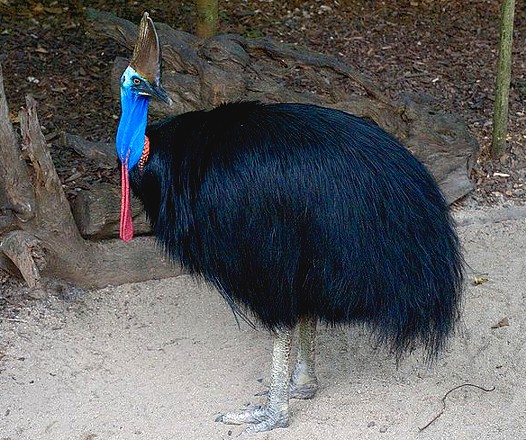
Casuario,
dal malese kasuwari, è un genere (Casuarius) di Uccelli Casuariiformi
della famiglia Casuariidi, ordine Struthioniformes, strettamente
imparentato con l'emù (Dromaius novaehollandiae![]() ), anch'esso
dell'ordine Struthioniformes. Il casuario è caratterizzato dalla
presenza di alcune caruncole - o bargigli - pendenti dal collo, dalla forma
dell'elmetto che sovrasta il capo e che è schiacciato in senso laterale, e
dal maggior sviluppo dell'unghia del dito più interno. Le varie specie si
differenziano per la forma dell'elmetto, per il numero e la disposizione delle
caruncole e per il colore del collo. La specie più nota è il casuario comune
(Casuarius casuarius) che vive nella Nuova Guinea e nell'Australia
nord-orientale. Altre specie sono il Casuarius bennetti (Nuova Guinea,
Nuova Britannia e isola di Yapen – nessuna caruncola) e il Casuarius
unappendiculatus (in Nuova Guinea settentrionale, sulle isole di Yapen,
Batanta e Salawati – una sola caruncola).
), anch'esso
dell'ordine Struthioniformes. Il casuario è caratterizzato dalla
presenza di alcune caruncole - o bargigli - pendenti dal collo, dalla forma
dell'elmetto che sovrasta il capo e che è schiacciato in senso laterale, e
dal maggior sviluppo dell'unghia del dito più interno. Le varie specie si
differenziano per la forma dell'elmetto, per il numero e la disposizione delle
caruncole e per il colore del collo. La specie più nota è il casuario comune
(Casuarius casuarius) che vive nella Nuova Guinea e nell'Australia
nord-orientale. Altre specie sono il Casuarius bennetti (Nuova Guinea,
Nuova Britannia e isola di Yapen – nessuna caruncola) e il Casuarius
unappendiculatus (in Nuova Guinea settentrionale, sulle isole di Yapen,
Batanta e Salawati – una sola caruncola).
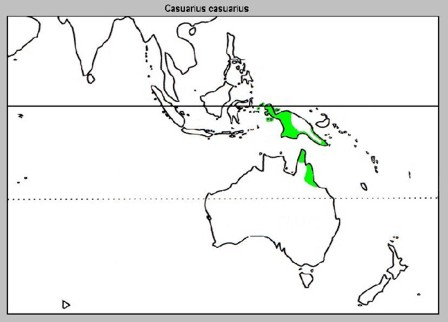
In base ai dati anatomici disponibili, il casuario possiede la lingua. Ciò che invece gli mancherebbe è un linguaggio percepibile dall'orecchio umano: «Voce a bassa frequenza del gigante casuario - È già stato definito il richiamo più profondo del mondo aviario. È quello del casuario, un gigantesco uccello (può arrivare a 60 kg) che vive nella Papua Nuova Guinea e che produce dei versi a bassa frequenza da non poter essere percepiti normalmente dall'orecchio umano. «Il suo modo di comunicare assomiglia a quello degli elefanti» ha affermato Andrew Mack della Wildlife Conservation Society. - Corriere della Sera – 2 novembre 2003 – pagina 22» Attenzione: il cigno muto (Cygnus olor) e l'anatra muta (Cairina moschata) non sono del tutto muti come indicherebbe l'aggettivo, in quanto qualche debole e stano suono percepibile dall'orecchio umano sono in grado di emetterlo.
I casuari, la cui altezza può superare il metro e mezzo, vivono di preferenza nelle zone boscose. Di carattere timido e diffidente, sono particolarmente attivi all'alba e al tramonto, quando vanno alla ricerca di cibo, rappresentato da vegetali, da invertebrati e da piccoli vertebrati. Le grandi uova, al massimo in numero di 8, vengono deposte in un avvallamento del terreno, previamente ricoperto di erbe e di foglie.
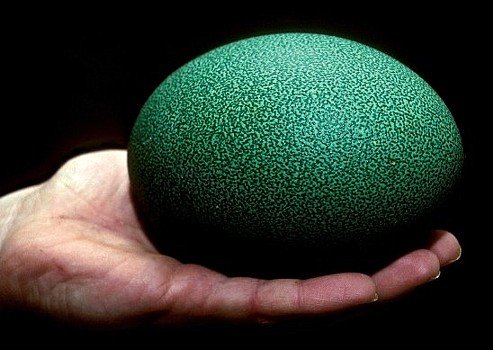
Tra luglio e settembre inizia il periodo degli amori: la femmina si accoppia con più maschi deponendo una covata da 3 a 8 uova di color verde più o meno pallido con un caratteristico guscio granulare, lunghe da 9 a 14 cm, incubate per 50-52 giorni.
Come accade per l'emù, anche nei casuari è il maschio che cova le uova e si prende cura dei piccoli (che presentano un piumaggio striato) per i loro primi nove mesi di vita. Il maschio di casuario è un uccello molto protettivo verso i suoi cuccioli: esso li difende con il grosso sperone che si trova sulle sue zampe, che corrisponde al maggior sviluppo dell'unghia del terzo dito più interno la quale può raggiungere i 12 cm. Con esso, il casuario ha ucciso anche alcuni esseri umani. Il nido del casuario è posizionato sovente nel sottobosco, ai piedi degli alberi ed è costituito da una bassa depressione, a volte imbottita con poche erbe e foglie cadute. Il temperamento del casuario è solitamente timido.
Struthio
camelus
a sinistra il maschio - a destra la femmina
A proposito dell'incubazione svolta dallo struzzo africano - Struthio camelus ordine Struthioniformes – possiamo dire che, a differenza di quanto accade per l'emù e per il casuario, a questo compito si dedica praticamente solo il maschio. Normalmente, una sola delle compagne che depongono e che sembra dominare gerarchicamente su tutte le altre, si occupa dell'incubazione durante il giorno, sostituita dal maschio dal tardo pomeriggio e per tutte le ore notturne; tuttavia, qualsiasi sia il numero delle uova, sembra che non più di 20-25 possano essere accudite, e solo queste si schiuderanno. Sovente le uova, soprattutto durante le ore più calde del giorno, vengono ricoperte di sabbia e abbandonate dalla femmina, affinché il loro processo di sviluppo dell'embrione si compia per effetto del calore naturale.
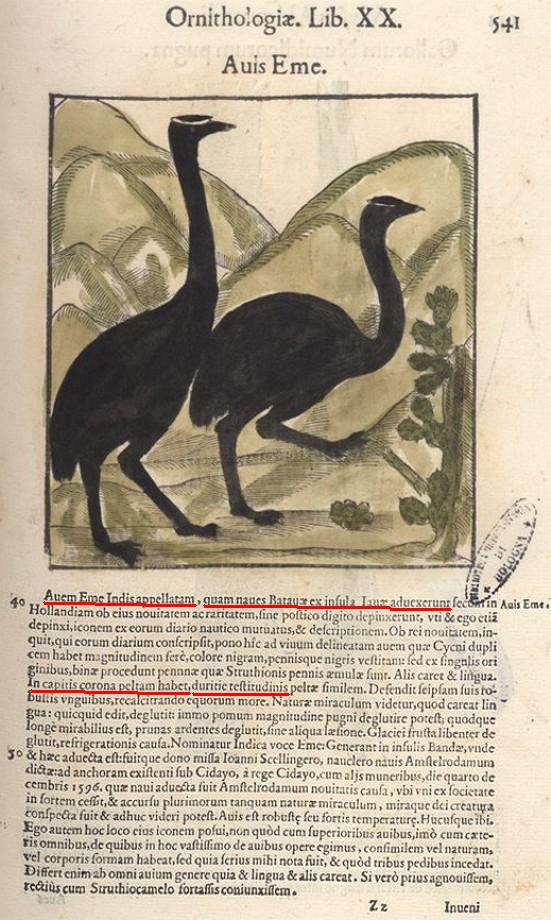
Il casuario presente a pagina 541 di
Ulisse Aldrovandi - Ornithologiae tomus
iii (1603)
Questo casuario dotato di elmo
fu etichettato col nome di Eme equivalente dell'odierno emù![]()
il quale è invece uno Struzioniforme del tutto privo di elmo.
Casuarius casuarius
Southern Cassowary
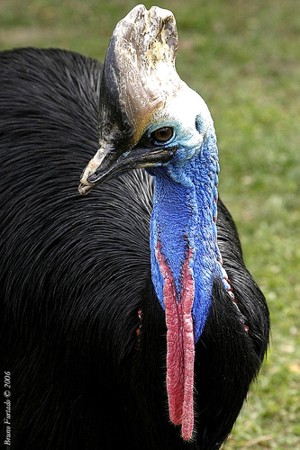
The Southern Cassowary, Casuarius casuarius, also known as Double-wattled Cassowary, Australian Cassowary or Two-wattled Cassowary, is a large flightless black bird. It is a ratite and therefore related to the Emu, Ostrich, and the genus Rhea (South America's Ñandú).
Detail of feet showing spearlike inner claw
The blade-like claws are capable of killing humans and dogs
if the bird is provoked.
It has hard and stiff plumage, a brown casque, blue face and neck, red nape and two red wattles hanging down its throat. The three-toed feet are thick and powerful, equipped with a lethal dagger-like claw up to 12 cm (4.7 in) on the inner toe. The plumage is sexually monomorphic, but the female is dominant and larger with a longer casque and brighter-colored bare parts. The juveniles have brown longitudinal striped plumage. It is the largest member of the cassowary family and is the second heaviest bird on earth, at a maximum size estimated at 85 kilograms (190 lb) and 190 centimetres (75 in). Normally this species ranges from 127 to 170 centimetres (50–67 in), with females averaging 58 kilograms (130 lb) and males averaging 29 to 34 kilograms (64–75 lb). It is technically the largest Asian bird (since the extinction of the Arabian Ostrich, and previously the Moa of New Zealand) and the largest Australian bird (though the Emu may be slightly taller).

The Southern Cassowary is distributed in tropical rainforests of Indonesia, New Guinea and northeastern Australia, and it prefers elevations below 1,100 m (3,600 ft) in Australia, and 500 m (1,600 ft) on New Guinea.
It forages on the forest floor for fallen fruit and is capable of safely digesting some fruits toxic to other animals. They also eat fungi, and some insects and small vertebrates. The Southern Cassowary is a solitary bird, that pairs only in breeding season, which takes place in late winter or spring. The male builds a nest on the ground; a mattress of herbaceous plant material 5 to 10 centimetres (2–4 in) thick and up to 100 centimetres (39 in) wide. This is thick enough to let moisture drain away from the eggs. The male also incubates the eggs and raises the chicks alone. A clutch of three or four eggs are laid measuring 138 by 95 millimetres (5.4 × 3.7 in). They have a granulated surface and are initially bright pea-green in colour although they fade with age. They make a booming call during mating season and hissing and rumblings otherwise. Chicks will make frequent high-pitches whistles to call the male.
Due to ongoing habitat loss, limited range and overhunting in some areas, the Southern Cassowary is evaluated as Vulnerable on the IUCN Red List of Threatened Species. The Australian population is listed as Endangered under Federal and Queensland State legislation. Some threats are through habitat loss (logging), feral animals eating their eggs, hunting, and roadkill. Road building, feral animals and hunting are the worst of these threats. It has an occurrence range of 396,000 km2 (153,000 sq mi), and between 10,000 and 20,000 birds were estimated in a 2002 study, with between 1,500 and 2,500 in Australia.
Presently, most authorities consider the Southern Cassowary monotypic, but several subspecies have been described. It has proven very difficult to confirm the validity of these due to individual variations, age-related variations, the relatively few available specimens (and the bright skin of the head and neck – the basis of which several subspecies have been described – fades in specimens), and that locals are known to have traded live cassowaries for hundreds, if not thousands, of years, some of which are likely to have escaped/been deliberately introduced to regions away from their origin.
Cassowaries, of the family Casuariidae, are closely related to the kiwis![]() in
the family Apterygidae, with these two bird families diverging from a common
ancestor 40 million years ago. The Southern Cassowary is in the class Aves,
which includes all birds; those that can fly as well as those that cannot. The
Aves, and thus the Southern Cassowary, share a common ancestor with reptiles
such as snakes, lizards, iguanas and crocodiles. They aren't very closely
related however with the common ancestor's divergence dating back 251 million
years ago.
in
the family Apterygidae, with these two bird families diverging from a common
ancestor 40 million years ago. The Southern Cassowary is in the class Aves,
which includes all birds; those that can fly as well as those that cannot. The
Aves, and thus the Southern Cassowary, share a common ancestor with reptiles
such as snakes, lizards, iguanas and crocodiles. They aren't very closely
related however with the common ancestor's divergence dating back 251 million
years ago.
Their binomial name Casuarius casuarius is derived from the Malay word kesuari, meaning cassowary. The Southern Cassowary was first described by Carolus Linnaeus in his 18th century work, Systema Naturae, as Struthio casuarius, from a specimen from Seram, in 1758. It is now the type species of the genus Casuarius. Seram (formerly Ceram, also called Seran or Serang) is an island in the Maluku province of Indonesia. It is located north of Ambon Island. The chief port/town is Masohi.